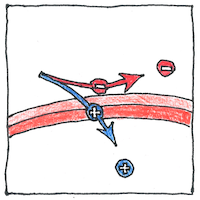Stephen Hawking
thermodynamics

|
Hawking radiation
A black hole by definition is an object so massive that it sucks in everything nearby including its own light. But there in space it sits, a perfect black body, reflecting nothing, so Stephen Hawkings said, like any other black body, a black hole is not a dead end, but has a temperature related to its mass and would gradually dissipate if other masses manage to avoid it.
Counter intuitive
Mathematics frees us from being limited to what we already expect. It isn’t limited to what we already know, showing truths we cannot otherwise foresee. Yakov Zeldovich and Alexei Starobinsky told Stephen Hawking that rotating black holes should emit particles, but when Hawkings did the math he found that all black holes emit radiation.
Small black holes
Small black holes form and eventually dissipate, even though scientists at CERN have been unable to create them. That could be funny, because they are all too obvious when you know where to look. Failures, heartbreaks, deaths puncture the fabric of normality. Without grace, they suck us in. Some holes, after their creation, grow by absorbing things that matter, consuming lives. Others wax and wane like the moon and, if we wait and wish enough, eventually disappear.



The magic of being human includes the logic of mathematics and, perhaps, a general failure to comprehend the enormous destructive powers of the universe and, in it, how small we are.
See also in The book of science:
Readings in wikipedia: